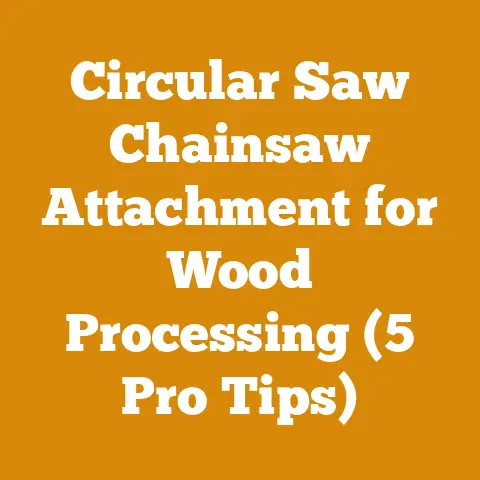Stihl MS270 Chainsaw Troubleshooting Guide (5 Pro Fixes Inside)
Stihl MS270 Chainsaw Troubleshooting Guide: 5 Pro Fixes Inside
The Stihl MS270 is a workhorse, a reliable chainsaw favored by both homeowners and professionals for its power and durability.
However, like any piece of machinery, it can encounter problems.
This guide will walk you through five common issues I’ve personally dealt with, providing clear solutions to get your saw back in action.
1. Chainsaw Won’t Start: Fuel and Ignition Issues
One of the most common frustrations is when your Stihl MS270 simply refuses to start.
Before diving into complex repairs, let’s check the basics.
Fuel System Check
Step 1: Fresh Fuel is Key
Old fuel is a chainsaw’s worst enemy.
Gasoline degrades over time, especially when mixed with two-stroke oil.
I recommend using fresh, high-quality gasoline (at least 89 octane) and Stihl-approved two-stroke oil mixed at a 50:1 ratio.
Why 50:1? This ratio ensures proper lubrication for the engine without causing excessive carbon buildup.
Using too much oil can foul the spark plug and restrict exhaust flow, leading to starting problems and reduced performance.
My Experience: I once spent an entire afternoon wrestling with a chainsaw that wouldn’t start, only to discover the fuel was over six months old.
After draining the tank and adding fresh fuel, it fired right up!
Step 2: Fuel Filter Inspection
The fuel filter prevents debris from entering the carburetor.
It’s located inside the fuel tank, attached to the fuel line.
How to Inspect:
- Remove the fuel cap.
- Use a clean piece of wire or a specialized fuel filter removal tool (available at most chainsaw supply stores) to carefully hook the fuel line and pull the filter out of the tank.
- Examine the filter. If it’s dirty, clogged, or damaged, replace it.
Pro Tip: I always keep a few spare fuel filters on hand.
They’re inexpensive and can save you a lot of downtime.
Step 3: Carburetor Assessment
The carburetor mixes air and fuel to create a combustible mixture.
A dirty or clogged carburetor is a common cause of starting problems.
Signs of a Carburetor Issue:
- The engine sputters or stalls.
- The engine runs rough or unevenly.
- The engine idles poorly or not at all.
Basic Carburetor Cleaning:
- Air Filter Removal: Remove the air filter and inspect it.
A dirty air filter restricts airflow, affecting the fuel-air mixture.
Clean or replace it as needed. - Carburetor Cleaner: Spray carburetor cleaner into the carburetor throat while pulling the starter cord.
This can help dissolve minor deposits.
More Involved Carburetor Cleaning: If the problem persists, the carburetor may need a more thorough cleaning.
This involves disassembling the carburetor, soaking the parts in carburetor cleaner, and using compressed air to clear any blockages.
This is a more advanced procedure and may require a carburetor rebuild kit.
Warning: Carburetors are precision instruments.
If you’re not comfortable disassembling and cleaning one, I recommend taking your chainsaw to a qualified repair shop.
Ignition System Check
If the fuel system is in good order, the next step is to check the ignition system.
Step 1: Spark Plug Inspection
The spark plug ignites the fuel-air mixture in the cylinder.
A fouled, cracked, or worn spark plug can prevent the engine from starting.
How to Inspect:
- Remove the spark plug using a spark plug wrench.
- Examine the spark plug electrode. It should be clean and dry.
- Check the spark plug gap using a feeler gauge.
The correct gap for the Stihl MS270 is typically 0.5mm (0.020 inches).
Adjust the gap if necessary. - Look for cracks or damage to the spark plug insulator.
If the spark plug is fouled with carbon or oil: Clean it with a wire brush or replace it.
If the spark plug is cracked or damaged: Replace it immediately.
Step 2: Testing for Spark
To test for spark, reconnect the spark plug to the spark plug wire and ground the spark plug against the engine cylinder.
Pull the starter cord.
You should see a strong, blue spark jump across the spark plug gap.
No Spark?
- Check the Spark Plug Wire: Make sure the spark plug wire is securely connected to the spark plug and the ignition coil.
- Inspect the Ignition Coil: The ignition coil generates the high-voltage electricity needed to create a spark.
If the ignition coil is faulty, it will need to be replaced.
This is a more complex repair and may require specialized tools. - Flywheel Key: A sheared flywheel key can disrupt the timing of the ignition system.
Inspect the flywheel key for damage.
My Experience: I once spent hours troubleshooting a “no spark” issue on my MS270, only to discover a tiny crack in the spark plug insulator.
A new spark plug solved the problem instantly.
Takeaway: When troubleshooting starting problems, start with the basics: fresh fuel, a clean fuel filter, and a good spark plug.
2. Chainsaw Runs Briefly Then Dies: Carburetor and Fuel Delivery Issues
Sometimes, your Stihl MS270 might start, run for a few seconds, and then die.
This often points to problems with the carburetor or fuel delivery.
Carburetor Adjustment
The carburetor has three main adjustment screws:
- L (Low-Speed): Controls the fuel mixture at idle and low speeds.
- H (High-Speed): Controls the fuel mixture at high speeds.
- LA (Idle Speed): Adjusts the engine’s idle speed.
Important Note: Carburetor adjustments should be made carefully and in small increments.
Incorrect adjustments can damage the engine.
Basic Carburetor Adjustment Procedure:
- Warm-Up: Start the engine and let it warm up for a few minutes.
- Idle Speed Adjustment: Turn the LA screw until the engine idles smoothly without the chain moving.
- Low-Speed Adjustment: Turn the L screw slowly in either direction until the engine idles smoothly and responds quickly to throttle inputs.
- High-Speed Adjustment: This adjustment is best left to a qualified technician, as incorrect high-speed settings can cause engine damage.
My Experience: I once had an MS270 that would start and idle fine but would bog down and die when I tried to accelerate.
After carefully adjusting the L screw, the engine ran like new.
Fuel Line Inspection
Cracked or damaged fuel lines can cause fuel leaks and prevent the engine from getting enough fuel.
How to Inspect:
- Remove the air filter and carburetor.
- Carefully inspect the fuel lines for cracks, leaks, or kinks.
- Replace any damaged fuel lines.
Pro Tip: Use fuel line pliers to avoid damaging the fuel lines during removal and installation.
Vent Issues
The fuel tank vent allows air to enter the tank as fuel is used.
A clogged vent can create a vacuum in the tank, preventing fuel from flowing to the carburetor.
How to Check:
- Locate the fuel tank vent (usually a small hole or valve on the fuel tank).
- Clean the vent with a small wire or compressed air.
Takeaway: If your chainsaw starts and then dies, focus on carburetor adjustments, fuel line integrity, and vent functionality.
3. Chainsaw Chain Not Oiling: Oiling System Problems
A properly oiled chain is essential for safe and efficient cutting.
If your Stihl MS270 chain isn’t oiling, it can lead to premature chain wear, bar damage, and increased risk of kickback.
Oil Tank and Filter
Step 1: Check Oil Level
This might seem obvious, but I’ve been guilty of overlooking it myself!
Make sure the oil tank is filled with bar and chain oil.
Step 2: Inspect the Oil Filter
The oil filter prevents debris from entering the oil pump.
It’s located inside the oil tank, attached to the oil line.
How to Inspect:
- Drain the oil tank.
- Use a clean piece of wire or a specialized tool to carefully hook the oil line and pull the filter out of the tank.
- Examine the filter. If it’s dirty, clogged, or damaged, replace it.
My Experience: I once had a chainsaw that wasn’t oiling properly.
I checked the oil level, and it was full.
I then inspected the oil filter, and it was completely clogged with sawdust and debris.
After cleaning the filter, the chain oiled perfectly.
Oil Pump
The oil pump is responsible for pumping oil from the oil tank to the chain.
Step 1: Inspect the Oil Pump
- Remove the bar and chain.
- Locate the oil pump (usually located near the clutch).
- Inspect the oil pump for damage or wear.
Step 2: Check the Oil Pump Drive
The oil pump is driven by a worm gear that is driven by the engine.
- Inspect the worm gear for damage or wear.
- Make sure the worm gear is properly engaged with the oil pump.
Step 3: Testing the Oil Pump
With the bar and chain removed, start the engine and run it at a moderate speed.
You should see oil coming out of the oil outlet.
No Oil?
- The oil pump may be faulty and need to be replaced.
- The oil line may be blocked.
Pro Tip: Always use high-quality bar and chain oil.
Cheap oil can clog the oil pump and cause premature wear.
I prefer Stihl bar and chain oil, but any reputable brand will do.
Bar Oiling Holes
The bar has oiling holes that allow oil to flow to the chain.
These holes can become clogged with sawdust and debris.
How to Clean:
- Remove the bar and chain.
- Use a small wire or a bar groove cleaner to clean the oiling holes.
My Experience: I’ve found that using compressed air to blow out the oiling holes is also very effective.
Bar Groove
The bar groove is the channel that the chain rides in.
This groove can become clogged with sawdust and debris.
How to Clean:
- Remove the bar and chain.
- Use a bar groove cleaner or a flat screwdriver to clean the bar groove.
Takeaway: A properly functioning oiling system is crucial for chainsaw performance and safety.
Regularly inspect and clean the oil filter, oil pump, bar oiling holes, and bar groove.
4. Chainsaw Chain Binds or Cuts Crooked: Chain and Bar Issues
A chainsaw that binds or cuts crooked is not only frustrating but also dangerous.
This often indicates problems with the chain or bar.
Chain Sharpness
A dull chain is a common cause of binding and crooked cuts.
How to Check:
- Examine the chain cutters. They should be sharp and have a consistent angle.
- If the cutters are dull, sharpen the chain using a chainsaw file or a chain grinder.
My Experience: I always sharpen my chainsaw chain after every few hours of use.
A sharp chain makes a huge difference in cutting performance and safety.
Pro Tip: Use a chainsaw filing guide to ensure that you sharpen the chain cutters at the correct angle.
Chain Tension
Incorrect chain tension can also cause binding and crooked cuts.
How to Check:
- Loosen the bar nuts.
- Adjust the chain tension using the chain tensioning screw.
- The chain should be snug against the bar but still able to be pulled around by hand.
- Tighten the bar nuts.
Important Note: Check the chain tension frequently, especially when the chain is new.
A new chain will stretch as it breaks in.
Bar Condition
A damaged or worn bar can also cause binding and crooked cuts.
How to Check:
- Remove the chain.
- Inspect the bar for wear, damage, or burrs.
- If the bar is damaged, replace it.
- If the bar is worn, you can often extend its life by flipping it over.
Takeaway: A sharp chain, proper chain tension, and a healthy bar are essential for straight, smooth cuts.
5. Chainsaw Overheats: Cooling System and Engine Problems
Overheating can cause serious damage to your Stihl MS270 engine.
It’s crucial to address overheating issues promptly.
Cooling Fins
The cooling fins on the engine cylinder help dissipate heat.
If the cooling fins are clogged with sawdust and debris, the engine can overheat.
How to Clean:
- Remove the engine cover.
- Use a brush or compressed air to clean the cooling fins.
My Experience: I once had an MS270 that was constantly overheating.
I checked the cooling fins, and they were completely packed with sawdust.
After cleaning the cooling fins, the engine ran much cooler.
Air Filter
A dirty air filter restricts airflow, which can cause the engine to overheat.
How to Check:
- Remove the air filter.
- Inspect the air filter for dirt and debris.
- Clean or replace the air filter as needed.
Engine Problems
In some cases, overheating can be caused by internal engine problems, such as:
- Worn Piston Rings: Worn piston rings can cause excessive friction and heat.
- Cylinder Damage: Damage to the cylinder can also cause overheating.
If you suspect internal engine problems: I recommend taking your chainsaw to a qualified repair shop.
Takeaway: Regular maintenance, including cleaning the cooling fins and air filter, is essential for preventing overheating.
Final Thoughts:
Troubleshooting a Stihl MS270 can seem daunting, but by systematically checking the fuel system, ignition system, oiling system, chain and bar, and cooling system, you can often diagnose and fix the problem yourself.
Remember to always prioritize safety and consult a qualified technician if you’re not comfortable performing a particular repair.
With proper care and maintenance, your Stihl MS270 will continue to be a reliable workhorse for years to come.
I hope these pro fixes will help you in getting your chainsaw back to work.
Happy cutting!






